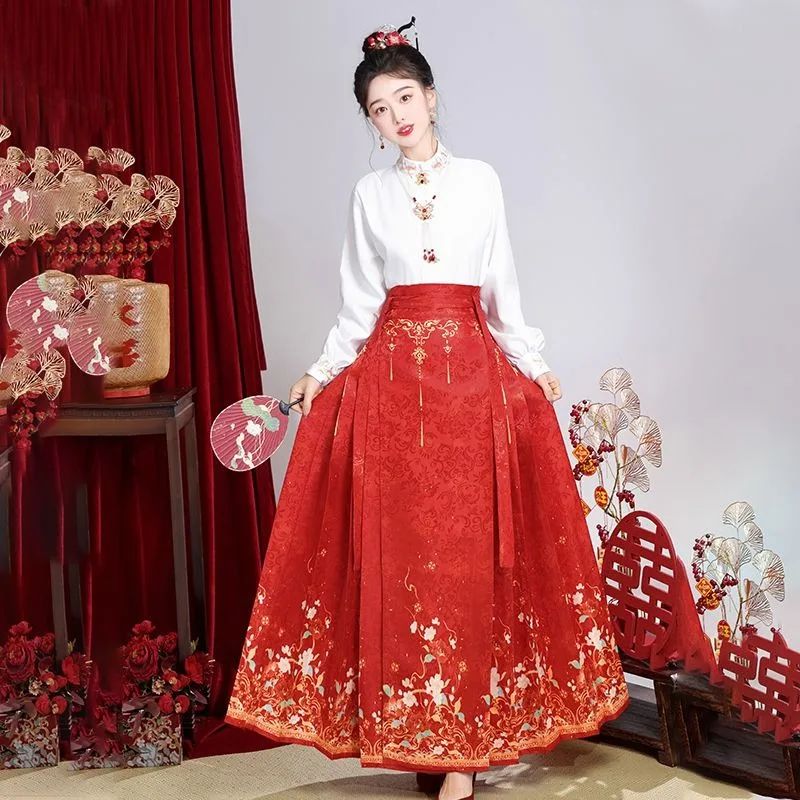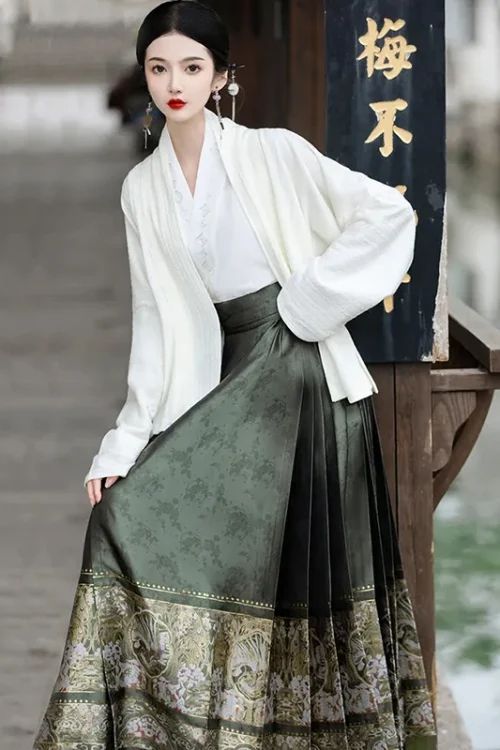The Significance of Colors in the 马绵群
The Mamianqun, a traditional Chinese headdress, is not merely an adornment but a canvas upon which a rich tapestry of symbolism is woven. Its intricate design conceals a profound language of colors, each hue carrying a specific meaning that reflects the wearer’s status, aspirations, and beliefs.

The Meaning of Colors
- 红色: The most prominent color in the Mamianqun, red symbolizes joy, prosperity, and good fortune. It is often used in wedding headdresses, representing the bride’s transition into a new and auspicious chapter of her life.
- 黄色: Associated with the emperor, yellow signifies power, authority, and nobility. It is reserved for headdresses worn by women of high rank, such as empresses and concubines.
- 绿色: The color of nature, representing growth, fertility, and harmony. Commonly found in headdresses worn by young women, it symbolizes their hopes for a prosperous future.
- 蓝色: Associated with the sky and water, blue represents tranquility, peace, and longevity. It is often used in headdresses worn by elderly women, signifying their wisdom and experience.
- 紫色: A rare and luxurious color, purple symbolizes wealth, elegance, and refinement. It is reserved for women of exceptional status, such as princesses and high-ranking officials.
- 黑色: The color of mourning, black is used in headdresses worn during funerals or periods of grief, representing sorrow, loss, and remembrance.
Additional Colors and Their Significance
Beyond these primary colors, the Mamianqun incorporates a variety of other hues, each with its own unique significance.
- 粉红色: Represents youth, innocence, and beauty.
- 橙色: Symbolizes enthusiasm, creativity, and joy.
- 白色: The color of purity and mourning, used in headdresses worn by widows or during periods of mourning.
Color Arrangement and Its Symbolic Meaning
The arrangement of colors on the Mamianqun is also highly symbolic:
- Red at the Front: Attracts good fortune and prosperity.
- Yellow at the Top: Signifies aspirations for power and authority.
- Green at the Sides: Represents hopes for growth and harmony.
结论
In conclusion, the Mamianqun is not merely a decorative accessory but a profound symbol of Chinese culture and tradition. Its intricate design conceals a rich language of colors, each hue carrying a specific meaning that reflects the wearer’s status, aspirations, and beliefs. By understanding the symbolism behind the Mamianqun, we gain a deeper appreciation for the cultural significance of this traditional Chinese headdress.
Animal Symbolism and Its Role in the Mamianqun
The Mamianqun, a traditional Chinese headdress worn by women of the Manchu ethnic group, is not merely an adornment but a rich tapestry of symbolism. Its intricate design conceals a wealth of hidden meanings that reflect the cultural beliefs and values of the Manchu people.
Crescent Shape and Its Symbolism
The Mamianqun’s most striking feature is its crescent-shaped top, which symbolizes the moon. In Manchu mythology, the moon is associated with fertility and abundance. The crescent shape also represents the female principle, complementing the male symbolism of the sun.
Adornments and Their Meanings
The headdress is adorned with numerous pearls, which represent purity and wealth. The pearls are often arranged in clusters, symbolizing the unity and harmony of the Manchu people. The tassels that hang from the Mamianqun represent longevity and good fortune.
Color Significance
The Mamianqun’s colors also carry symbolic significance. The most common color is red, representing joy, prosperity, and good luck. Other colors, such as blue and green, are associated with nature and the elements.
Variations by Age and Status
The design of the Mamianqun is not static but varies depending on the wearer’s age and social status. Unmarried women wear a Mamianqun with a single crescent, while married women wear one with two crescents. The number of pearls and tassels also increases with age, reflecting the wearer’s growing maturity and experience.
Cultural Heritage
The Mamianqun is not only a symbol of Manchu identity but also a testament to the group’s artistic and cultural heritage. Its intricate design and rich symbolism have been passed down through generations, preserving the traditions and beliefs of the Manchu people.
结论
In conclusion, the Mamianqun is more than just a headdress; it is a living symbol of Manchu culture. Its design is a tapestry of hidden meanings that reflect the group’s beliefs about fertility, wealth, unity, and good fortune. By understanding the symbolism behind the Mamianqun, we gain a deeper appreciation for the rich cultural heritage of the Manchu people.
The Hidden Meanings Behind the Geometric Patterns in the Mamianqun
The Mamianqun, a traditional Chinese garment worn by the Manchu people, is not merely a piece of clothing but a canvas upon which a rich tapestry of symbolism is woven. Its intricate geometric patterns, far from being mere decoration, hold profound meanings that reflect the cultural beliefs and values of the Manchu people.

Yin and Yang
The Mamianqun’s design is rooted in the ancient Chinese concept of yin and yang, representing the opposing yet complementary forces of nature. The garment’s two main colors, blue and red, symbolize these forces: blue representing the sky and water (yin), while red represents the sun and fire (yang). The harmonious balance of these colors reflects the Manchu belief in the interconnectedness of all things.
Natural Elements in the Design
Beyond yin and yang, the Mamianqun’s patterns also incorporate elements from the natural world.
- Cloud Collar: Evokes the auspicious clouds that bring rain and fertility.
- Horsehoof Cuffs: Symbolize strength and agility, qualities highly valued by the nomadic Manchu people.
- Fish Scale Pattern: Represents abundance and prosperity, a wish for a bountiful life.
Symbolism of Construction
The Mamianqun’s symbolism extends to its construction as well. The garment is typically made from silk, a luxurious fabric that signifies wealth and status. The intricate embroidery and beadwork that adorn the Mamianqun are not only decorative but also serve as a form of storytelling, depicting scenes from Manchu history and mythology.
Cultural and Social Significance
The Mamianqun’s symbolism is not limited to its physical appearance. It carries cultural and social significance, often worn on special occasions, such as weddings and festivals, and is considered a symbol of Manchu identity. By wearing the Mamianqun, Manchu people express their pride in their heritage and their connection to their ancestors.
结论
In conclusion, the Mamianqun is not merely a garment but a repository of cultural symbolism. Its geometric patterns, colors, and construction all hold profound meanings that reflect the beliefs, values, and aspirations of the Manchu people. By understanding the hidden meanings behind its design, we gain a deeper appreciation for the richness and complexity of Manchu culture.
